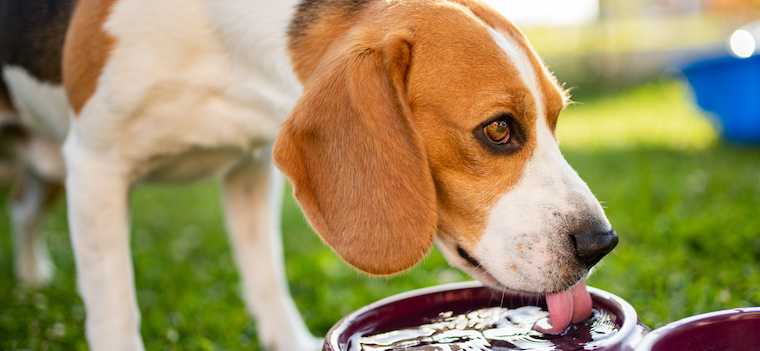Playing outside with your dog is a summer tradition, but sometimes excessive fun in the hot summer sun can be too much for your pet. We’ll outline the prevention, symptoms, and initial treatment of heat stroke so that you and your dog can have a safe summer of fun together.
Heat exhaustion, also known as hyperthermia, happens when your pet’s temperature rises so high that it’s unable to regulate its own body heat. A mild case can be treated at home, but a more severe case could cause a high fever, loss of consciousness, or even organ failure in your pet.
Dogs are more sensitive to heat exhaustion because they don’t sweat to get rid of body heat; they pant, rest, and drink water to cool off.
Here are a few tips for preventing heat exhaustion:
- If your dog stays outside a lot, make sure they have ample water and cool shady spots. During peak temperatures, try to bring them indoors to cool off.
- Never leave your dog inside a parked car, even with the window cracked. Temperatures on a 70 degree day can rise to 100 degrees in just 20 minutes. Studies also show that cracking your car window doesn’t allow for proper cooling so it’s not a safe practice.
- Don’t walk your dog during peak temperatures. Choose a time when temperatures are lower, and bring water with you so your dog can hydrate regularly.
- If you are traveling on vacation, don’t leave him at your home to have someone check on him. Board your dog at a reputable boarding facility where he can stay cool, hydrated and cared for.
If you notice the following symptoms, your dog could be over heated or be experiencing heat exhaustion. Watch out for: excessive panting or difficulty breathing; dehydration; excessive drooling; fever (over 103 degrees); lack of urine; red, gray, purple or bluish gums; muscle tremors; lethargy; vomiting/diarrhea; or dizziness.
If your pet has experienced any of these symptoms, here are some tips for cooling him down:
- Bring him indoors.
- Wet a wash rag with cool (not cold) water and thoroughly wet him down with a water compress. Put him in front of a fan to dry off.
- If you have a pet thermometer, check his temperature every few minutes. Once the temperature drops below 103 degrees, you can stop applying water compresses.
- As he cools down, provide small amounts of lukewarm water.
Finally, give us a call at Animal Clinic of Woodruff as soon as possible. Even if they are cooling down, dogs likely need to be monitored for shock, dehydration, and possible organ failure. We will advise you on next steps.
With a little extra care this summer, you and your pet can have a lot of fun!




